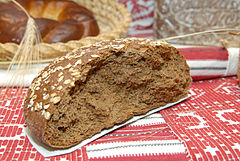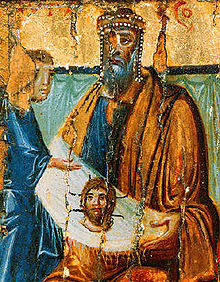
Julian Alexandrovich Scriabin was a Swiss-born Russian composer and pianist who was the youngest son of Alexander Scriabin and Tatiana de Schloezer.
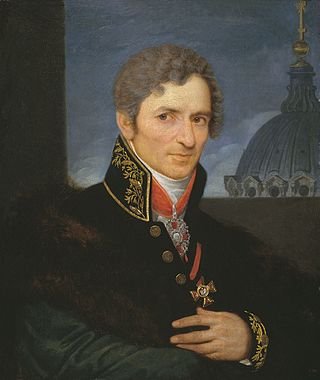
Andrey (Andrei) Nikiforovich Voronikhin was a Russian architect and painter. As a representative of classicism he was also one of the founders of the monumental Russian Empire style. Born a serf of the Stroganov family, he is best known for his work on Kazan Cathedral in Saint Petersburg.
Oleg Nikolayevich Trubachyov was a Russian linguist. A researcher of the etymology of Slavic languages and Slavic onomastics, he was considered a specialist in historical linguistics and lexicography. He was a Doctor of Sciences in Philological Sciences, an academician of the Russian Academy of Sciences and served as the editor-in-chief of the Etimologiya yearbook. His works are on the etymology of Slavic languages and on East Slavic onomastics.

Vitebsk Museum of Modern Art was an art museum in Vitebsk, Belarus organized in 1918 by Marc Chagall, Kazimir Malevich and Alexander Romm. In 1921, it exhibited 120 paintings "representing all the movements of the contemporary art from the Academic Realism to Impressionism to Suprematism". In the mid-1920s, the museum was closed. While some paintings have found their way to museums of Russia and Belarus, the whereabouts of many paintings are unknown.

Beklemishevskaya Tower is a tower at the Eastern edge of Moscow Kremlin Wall. It was named after a boyar Ivan Bersen-Beklemishev, whose house had been adjacent to the tower from the Kremlin side. It was earlier known as Russian: Москворецкая tower based its position on the near Moskva River. It is similar to the other two towers standing at the other corners of the Kremlin triangle, Vodovzvodnaya and Uglovaya Arsenalnaya rowers. While these towers are cylindrical, all other towers of the Kremlin's Wall have been built on a square plan base.

Jasef Alexandrovich Serebriany was a Soviet painter and stage decorator, who lived and worked in Leningrad, a member of the Leningrad Union of Artists, People's Artist of the Russian Federation, professor of the Repin Institute of Arts, regarded as one of the leading representatives of the Leningrad school of painting, well known for his portrait paintings.

Alexander Vladimirovich Bykov is a Russian historian and ethnographer, one of the leading Russian specialists in numismatics. Publisher, founder of the first Russian private museum of political history, the Museum of Diplomatic Corps in Vologda, Russia; he is the author of multiple articles, books, and popular science publications.
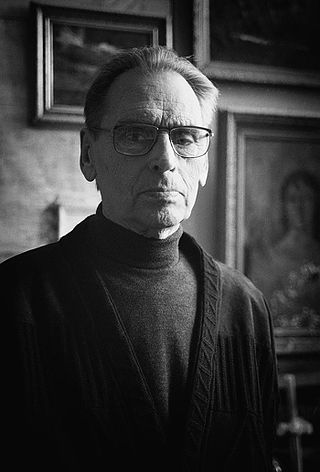
Lev Konstantinovich Bogomolets was a Soviet Russian painter, a member of the Saint Petersburg Union of Artists, who lived and worked in Saint Petersburg, regarded as one of representatives of the Leningrad school of painting, most famous for his landscape paintings.

Freemasonry in Russia started in the 18th century and has continued to the present day. Russian Freemasonry pursue humanistic and educational purposes, but more attention is given to ethical issues. It was a spiritual community of people united in an effort to contribute to the prosperity of the Motherland and the enlightenment of the people living in it.

The Kórmchaia Book, also known as the Books of the Pilot (Russian: Ко́рмчая книга, Ко́рмчая from кормчий, Church Slavonic: кръмьчии 'helmsman, ship's pilot'; Pidalion or Nomocanon, are collections of church and secular law, which constituted guide books for the management of the church and for the church court of Orthodox Slavic countries and were also the transmission of several older texts. They were written in Old Church Slavonic and Old East Slavic.

Merílo Právednoye or Just Measure is an Kievan Rus' legal collection from the late 13th or early 14th century, preserved in the copies of the 14th to the 16th centuries. The name was given in modern literature, taken from the first words of this text: "this books is just measure, true weighing...". Just Measure was written in Old Church Slavonic and Old Russian.

The Regional Art Exhibition "Our Contemporary" became one of the most important and largest Soviet Art exhibition of the 1970s. The Exhibition took place in the State Russian Museum and in the exhibition halls of the Leningrad Union of Soviet Artists.
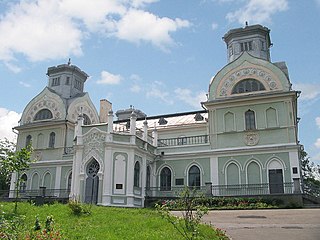
The Lopukhin family was a noble family of the Russian Empire, forming one of the branches of the Sorokoumov-Glebov family.
Tyurya, sometimes known as murtsovka, is a traditional bread soup in the Russian cuisine, sometimes considered a variant of okroshka. It consists of chunks of bread, often stale or semi-stale, or dried/baked into sukhari biscuits/hardtack, soaked in a flavorful liquid or, alternatively, plain water, with some vegetables and vegetable oil added and flavored with salt and pepper. The base liquid could be anything that can be consumed cold, because unlike most other bread soups, tyurya was prepared and consumed without heat. Kvass was historically the most popular base for tyurya, due to it being cheap, plentiful and flavorful enough. A dairy base, like plain or sour milk, whey or kefir was considered fancy and was generally prepared for children, the elderly or the infirm. It is, along with pokhlyobka, a traditional Lenten soup.
The Komi language, a Uralic language spoken in the north-eastern part of European Russia, has been written in several different alphabets. Currently, Komi writing uses letters from the Cyrillic script. There have been five distinct stages in the history of Komi writing:

Kryukov Canal is one of the canals in central Saint Petersburg, Russia.
Evenki orthography is the orthography of the Evenki language.

Batlejka is a Belarusian amateur puppet theatre. Its name is derived from the city of Bethlehem and performances are traditionally given over the Christmas period.

Lev (Leo) Platonovich Karsavin was a Russian religious philosopher, historian-medievalist, and poet.

Moscow Courtyard is a landscape painting by the Russian artist Vasily Polenov (1844-1927), completed in 1878. It belongs to the State Tretyakov Gallery. Its dimensions are 64.5 × 80.1 cm. Together with two other works by Polenov from the late 1870s: the paintings "Grandmother's Garden" and "Overgrown Pond", the canvas "Moscow Courtyard" has been attributed to "a kind of lyrical and philosophical trilogy of the artist".
